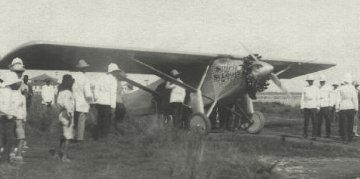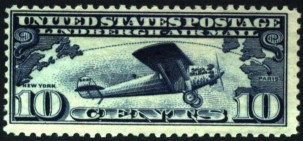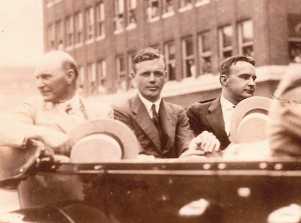Charles Lindbergh - The Lone Eagle
First Man to Fly the Atlantic Solo
By Stephen Sherman, Jan. 2001. Updated June 26, 2011.
On May 20-21, 1927 Charles Lindbergh made the first solo, nonstop New York to Paris flight in the Spirit of St. Louis. After the 3,610-mile, 34 hour, flight across the Atlantic, Lindbergh became an international hero, and the most famous man in the world. Today, his airplane, the Spirit of St. Louis, hangs in the atrium of the National Air and Space Museum.
After bursting into international fame with his transatlantic flight, Lindbergh remained in the public eye, often the subject of controversy. Retiring in later years to the island of Maui, Hawaii, he died there in 1974.
Youth
Born on , Lindbergh was mechanically inclined from childhood. The son of a Swedish immigrant, Charles August "C.A." Lindbergh, and his second wife, Evangeline Land, young Charles had a rootless and somewhat solitary childhood. For many years he and his mother moved between their primary home in Little Falls, Minnesota, her family's house in Detroit, and Washington, D.C., where his Congressman father spent a most of his time. His father's house is now a National Historic Landmark. Charles had no siblings his age (two much older half-sisters) and few close friends his own age. He learned to love nature, the outdoors, solitude, and developed a passion for collecting and analyzing things.
Barnstormer & Air Mail Pilot
Fascinated with aviation, he earned his pilot's license, and in 1923 bought a Jenny to take up barnstorming.
In 1924, Lindbergh entered a U.S. Army flying school at San Antonio, Texas. He graduated first in his class the following year, then became the first air mail pilot between Chicago, Illinois, and St, Louis, Missouri. He became the first three-time member of the Caterpillar Club, that exclusive fraternity of people who had saved their lives with parachutes. While he loved flying of any sort, the airmail routine was tedious. He heard of a fine new airplane, the Wright Bellanca, whose engine promised to give it a range of 4,000 miles. He pondered what could be achieved in such a machine.
His Transatlantic Flight
In 1919, New York hotel businessman Raymond Orteig had offered a $25,000 prize for the first nonstop flight between New York and Paris. Several attempts had been made to capture the prize, notably by French WWI ace, Rene Fonck, in 1926. The transatlantic challenge became somewhat of a national obsession. Lindbergh convinced a group of St. Louis businessmen to back him in an attempt to win the Orteig prize. They committed $10,000 for his plan. On a tight budget, he went looking for an airplane. At first, Charles Levine, the owner of the Wright Bellanca offered it to him for only $15,000, a great discount from its cost of $25,000. His backers okayed the extra funds. After excitedly traveling to New York to finalize the deal, Lindbergh was dismayed to learn that while Levine would sell him the Bellanca, he insisted on naming the pilot himself. Lindbergh looked for other aircraft. Other manufacturers were unhelpful.
At this time, early 1927, the Orteig challenge was heating up,
amidst great publicity. Rene Fonck was rumored to be preparing another
attempt in a new Sikorsky biplane. Richard Byrd, of North Pole fame,
had an expensive Fokker trimotor for his effort. Levine and Clarence
Chamberlin announced they would try it in the Wright Bellanca. Another
pair of Americans, Noel Davis and Stanton Wooster, would also enter.
The race was on.
Spirit of St. Louis
A small manufacturer, the Ryan Aeronautical Company of San Diego, agreed to build a plane for Lindbergh, for $6,000 plus the cost of the engine. He went to their small plant in San Diego and supervised the design modifications and the construction his monoplane. Essentially, the Spirit of St. Louis was a custom-built airplane, designed expressly to fly Lindbergh across the Atlantic. A. Scott Berg, in Lindbergh, called it a "two-ton flying gas tank." Lindbergh sacrificed every possible bit of weight for more fuel capacity. No parachute, no radio, no brakes, not even a forward-facing window (a small periscope would do). Twenty-seven feet long, as the design evolved, the wings grew to forty-five feet, to help lift the 2700 pounds (400+ gallons) of gas. The rest of the airplane, the engine, and its pilot only weighed about 2500 pounds.
Powered by a state-of-the-art 223hp Wright Whirlwind J-5C engine, the plane could cruise for 4,200 miles. Ryan employees worked day and night to finish the aircraft in just two months. Its tail identified the aircraft as "N-X-211 RYAN NYP" "N" was the international aeronautical code for the United States. "X" stood for experimental. It was the 211th such licensed plane. "RYAN NYP" abbreviated "Ryan New York - Paris."
Check out the NASM Spirit of St. Louis web page. Engine installed, Ryan charged him $10,580. The press (Lindbergh's nemesis for the rest of his life) got word of this new entrant, and began to tell the country about the handsome young man and his bold, solitary plan. A lone pilot in a single-engine plane allowed little margin for error. In April, as the Spirit neared completion, Noel Davis and Stanton Wooster crashed and died while testing their plane, the American Legion. Commander Byrd's Fokker, America, cracked up and injured three of its crew. Clarence Chamberlin and Levine's Bellanca, named the Columbia, smashed up it landing gear.
By May, after short test flights around Southern California, Lindergh and the Spirit of St. Louis were ready. On the 8th came dramatic news, two French aviators, Charles Nungesser (a WW1 ace) and Francois Coli, had taken off from Paris in L'Oiseau Blanc, the White Bird. They were never heard from again. Undeterred, Lindbergh flew to New York. Stopping briefly in St. Louis to re-fuel, he set a new record for the California-to-New York run, flying it in less than 22 hours. Photographers and reporters greeted him on his arrival at Curtiss Field on Long Island. The other competitors had various problems - Levine was held up by lawsuits, Byrd's trimotor needed work. On the 19th, Lindbergh was ready. They needed to check out the plane thoroughly, which required several short flights around the field. As they finished the preparations for the long flight, reports came in of heavy fog over Nova Scotia and Newfoundland, postponing his take-off.
The Flight
But on the morning of May 20, 1927, an improved weather forecast suggested no advantage in further delay. They installed and sealed the barograph, and serviced and checked the plane, then Lindbergh took off from Roosevelt Field on Long Island. For food, he brought five sandwiches. "If I get to Paris, I won't need any more. And if I don't get to Paris, I won't need any more, either," Lindbergh noted drily. Fox Movietone captured his Ryan monoplane, loaded with 451 gallons of fuel, struggling and bouncing along the runway, barely clearing the telephone wires at the far end. After clearing St. John's, Newfoundland, the 25-year old aviator was hidden from the world. The world waited, spell-bound for word of Lindbergh. Rumors flew. (My Dad, eight years old at the time, recalled waiting for news of Lindbergh. His older brother "came stumping into the house and reported that Lindbergh had crashed. My mother broke down and cried. But of course it wasn't so." - SS)
Encountering fog and sleet, he was compelled to fly blind part of the way at an altitude of 1500 feet. At times he flew only 10 feet above the waves. Sighting the coast of Ireland, he turned south towards France. He flew over England and the Channel, and sighted the lights of Paris at 10 o'clock. He shortly touched down at Paris' Le Bourget Field, 33 hours and 30 minutes after he left Long Island. He had covered a distance of 3,610 miles. By making the flight, Lindbergh collected Orteig's $25,000 prize.
You can read an excellent book devoted to this event, entitled The Flight of the Century: Charles Lindbergh and the Rise of American Aviation
The world, and his life, had changed forever. Hundreds of thousands of people met him in Paris. Lionized throughout the city, U.S. Ambassador Myron Herrick took him in, and even arranged for a tailor to sew him new clothes. His triumphant tour of Europe included meeting the kings of Belgium and Britain.
The picture at left shows him during a parade in his honor in
Hartford, Connecticut, riding in a car with Governor John Trumbull and
Mayor Houghton Bulkley.
The U.S. Navy cruiser Memphis returned the hero to America. First to Washington, where President Coolidge received him, and then to New York City and its largest ticker tape parade ever. The U.S. Post Office issued an unprecedented commemorative airmail stamp in his honor. U.S. stamps never feature living persons, and thus only Lindbergh's plane and a map of his route were shown.
As part of his backers' agreements, he had given the New York
Times exclusive coverage of his story and the rights to his authorized
story. Lindbergh was so disgusted with ghost-writer Carlyle MacDonald's
corny and inaccurate articles that first appeared, he vowed to control
anything ever published in his name. He also realized the importance of
careful documentation, and began saving all his correspondence and
personal papers. (This has been a boon to scholars and historians.)
Committed to produce a 40,000 word book, he buried himself at Falaise, Harry Guggenheim's Long Island estate, and wrote We in one month. It was well-written, spare and accurate, and became an immediate best-seller. (Check out a lengthy review of We at Amazon.)

In December, 1927, he flew the Spirit to Mexico, Guatemala, Belize, and other Cental American countries. In Mexico, he first met Ambassador Dwight Morrow and his daughters.
On his return to the U.S., he devoted himself to the development of aviation, helping to start the airline that would become TWA.
Continue reading Lindbergh article, page 2
Sources:
- PBS - The American Experience, Lindbergh episode - lots about his America Firster days and his peculiar political ideas
- Lindbergh Foundation website
- Charles A. Lindbergh and the Battle Against American Intervention in WWII, Wayne Cole, Harcourt Brace, 1974.




